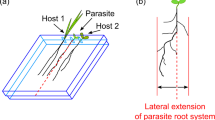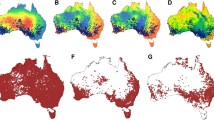Summary
Rhinanthus minor (Yellow-rattle) was grown in replacement series mixtures with Lolium perenne and Trifolium repens. The hemiparasitic interaction resulted in Relative Yield Totals (the sum of the yields in mixture relative to those in monoculture) considerably above 2. The hemiparasite caused a greater decrease in the yield of the legume and also performed better on the legume, indicating that T. repens was a better host for R. minor than L. perenne under the experimental conditions. When L. perenne and T. repens were grown in binary mixture with or without R. minor the hemiparasite affected considerably the competitive relationship between the two species by selectively parasitizing the legume. The effect of R. minor on competition between the two species was, however, dependent upon the nutrient status of the soil: the higher the level of soil nitrogen the fewer haustorial connections were made with T. repens and the less was the depression in its yield. In another series of experiments in which Festuca rubra, Holcus lanatus and L. perenne were grown in various binary mixtures with or without R. minor it was also shown that the yield of a preferred host was depressed to the advantage of a non-preferred host. It is suggested that the mediation of competition by the hemiparasite provides a mechanism by which it might affect the structure and diversity of plant communities.
Similar content being viewed by others
References
Atsatt PR (1970) Biochemical bridges between vascular plants. In: Chambers KL (ed) Biochemical Evolution: Proceedings of the 29th Annual Biology Colloquium. Oregon State University Press, pp 53–68
Atsatt PR, Strong DR (1970) The population biology of annual grassland hemiparasites. I. The host environment. Evolution 24:278–291
Begon M, Mortimer M (1986) Population Ecology (2nd edition). Blackwell Scientific Publications, Oxford
Bentley SJB, Whittaker JB (1979) Effect of grazing by a chrysomelid beetle, Gastrophysa viridula, on competition between Rumex obtusifolius and Rumex crispus. J. Ecol 67:79–90
Bergh JP van den, Braakhekke WG (1978) Coexistence of plant species by niche differentiation. In: Freysen AHJ, Woldendorp JW (eds) Structure and functioning of plant populations. North Holland Publishing Company, Amsterdam, pp 125–138
Borg SJ ter, Bastiaans JC (1973) Host parasite relations in Rhinanthus serotinus. I. The effect of growth conditions and host; a preliminary review. In: Proceedings of the European Weed Research Council Symposium on parasitic weeds. Malta University Press, pp 236–246
Burdon JJ, Chilvers GA (1977) The effect of barley mildew on barley and wheat competition in mixtures. Aust J Bot 25:59–65
Burdon JJ, Groves RH, Kaye PE, Speer SS (1984) Competition in mixtures of susceptible and resistant genotypes of Chondrilla juncea differentially infected with rust. Oecologia 64:199–203
Cantlon JE, Curtis EJC, Malcolm WM (1963) Studies of Melampyrum lineare. Ecology 44:466–474
Cottam DA (1985) Frequency-dependent grazing by slugs and grasshoppers. J Ecol 73:925–933
Fitter AH (1977) Influence of mycorrhizal infection on competition for phosphorus and potassium by two grasses. New Phytol 79:119–125
Gibson CC, Watkinson AR (1989) The host range and selectivity of a parasitic plant: Rhinanthus minor L. Oecologia 78:401–406
Govier RN, Harper JL (1964) Hemiparasitic weeds. Proc 7th Br Weed Control Conf 7:577–582
Govier RN, Nelson MD, Pate JS (1967) Hemiparsitic nutrition in angiosperms I. The transfer of organic compounds from host to Odontites verna (Bell.) Dum. (Scrophulariaceae). New Phytol 66:285–297
Hodgson JF (1973) Aspects of the Carbon Nutrition of Angiospermous Parasites. PhD thesis, University of Sheffield
Hullu E de (1984) The distribution of Rhinanthus angustifolius in relation to host plant species. In: Parker C, Musselman LJM, Polhill RM, Wilson AK (eds) Proceedings of the Third International Symposium on Parasitic Veeds. Icarda, Aleppo, Syria, pp 43–53
Pate JS, Pate SR, Kuo J, Davidson NJ (1990) Growth, resource allocation and haustorial biology of the root hemiparasite Olax phyllanthi (Olaceae). Ann Bot 65:437–449
Press MC (1989) Autotrophy and heterotrophy in root hemiparasites. TREE 4:258–263
Rabotnov TA (1959) The effect of Rhinanthus major Ehrh. upon the crops and the composition of the flood land herbage. Byulleten' M Obschchestva Ispyt Priroda 64:105–107
Snogerup B (1982) Host influence on northwest European taxa of Odontites (Scrophulariaceae). Ann Bot Fenn 19:17–30
Vallance KB (1952) The germination of seeds of Rhinanthus cristagalli. Ann Bot 16:409–420
Weber HC (1975) Über Wirtspflanzen und Parasitismus einiger mitteleuropäischer Rhinanthoideae (Scrophulariaceae). Plant Syst Evol 125:97–107
Wit CT de (1960) On competition. Versl Landbouwk Onderz 66:1–82
Yeo PF (1964) The growth of Euphrasia in cultivation. Watsonia 6:1–14
Author information
Authors and Affiliations
Rights and permissions
About this article
Cite this article
Gibson, C.C., Watkinson, A.R. Host selectivity and the mediation of competition by the root hemiparasite Rhinanthus minor . Oecologia 86, 81–87 (1991). https://doi.org/10.1007/BF00317393
Received:
Accepted:
Issue Date:
DOI: https://doi.org/10.1007/BF00317393




